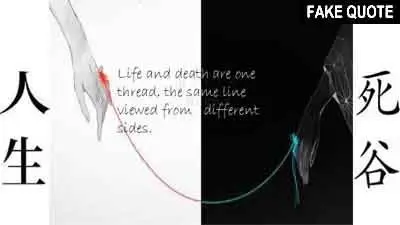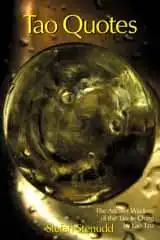|
Tao Te Ching
THE TAOISM OF LAO TZU
|
Fake Lao Tzu Quote"Life and death are one thread..."
This is NOT a quote from Tao Te Ching:"Life and death are one thread, the same line viewed from different sides."
It amazes me that this quote ever got attributed to Lao Tzu. He was definitely not the one to speculate about death and its possible meaning or nature. He made no claim in Tao Te Ching of death being anything but the abrupt end of life. The quote makes little or no sense. If it said birth and death it would be understandable. At birth you have that long line of life in front of you, whereas at the point of death you have it behind you. Not that it is anything more than a truism, but it is still undeniable. Lao Tzu played with truisms in Tao Te Ching, but he took them somewhere. He made them reveal profound things. But this quote is just a statement of the obvious — at best. Its wording really makes it completely meaningless.
I could not find a Tao Te Ching version containing this quote. I can't even imagine what lines in the text might be misinterpreted in this way. I suspect it is just a quote from wherever, attributed to Lao Tzu by someone along the way. Checking Facebook, I found no occurrence of the quote until a post from March 28, 2011. It stated Lao Tzu as the author. There was a meme posted as well. I don't know if it was made by the one posting it (Maria Manalang) or not. There were a couple of more quotes on Facebook each year from 2013 and 2016 (none in 2012), and in 2017 there was suddenly a bundle of them — although my search was done already at the end of March that year. Several years earlier, though, the quote appeared in printed literature. Treasury of Spiritual Wisdom: A Collection of 10,000 Inspirational Quotations from 1996, by Andy Zubko, has the exact quote and accredits it to Lao Tzu (page 88), giving no source to it. There are six other Lao Tzu quotes in the book, five of which are equally doubtful — among them the "Kindness in words" quote (page 283) and the "There are many paths" quote (page 128), discussed in the chapters with those names. The others are:
But there is an earlier source to the quote examined here, and it excuses Andy Zubko's mistake. It can be found in Chuang Tsu: Inner Chapters from 1974, translated by Gia-Fu Feng and Jane English. They also made a widespread translation of Tao Te Ching, discussed in the chapters He who controls others and Knowing others. Chuang Tzu was a prominent Taoist, second only to Lao Tzu, who lived in the 4th century BC. Here is the passage of the Chuang Tzu text, where a man called No-toes discusses Confucius' shortcomings with Lao Tzu (page 101):
In conclusion, then, the origin of the quote is Chuang Tzu — or his students writing his words down. So, although it is not to be found in Tao Te Ching, it is hard to deny as a Lao Tzu quote, after all. And it is far too late to discuss with Chuang Tzu to what extent the quote is a true representation of Lao Tzu's ideas. The quote belongs to the 5th book of Chuang Tzu, called "The Seal of Virtue Complete" in Legge's translation, which belongs to the seven so-called inner chapters. These are the ones generally assumed to have been written by Chuang Tzu, but this is difficult to ascertain. Also, it can be debated what source Chuang Tzu might have had to what Lao Tzu said outside of the words of Tao Te Ching. Still, the possibility of it being a genuine Lao Tzu quote cannot be dismissed, though the wording about life and death being one thread might not be the most accurate translation.
Stefan Stenudd April 2, 2017, revised September 9, 2020.
More Fake Lao Tzu QuotesThere are many more fake Lao Tzu quotes examined on this website. Click the header to see a list of them.
Fake interview with the authorClick the header to read a "fake" interview with Stefan Stenudd, the author of Fake Lao Tzu Quotes.
About CookiesMy Other Websites:I Ching OnlineThe 64 hexagrams of the Chinese classic I Ching and what they mean in divination. Try it online for free.
Qi Energy ExercisesThe ancient Chinese life energy qi (chi) explained, with simple instructions on how to exercise it.
Life EnergyThe many ancient and modern life force beliefs all over the world explained and compared.
Taoismen på svenska
Other Books by Stefan StenuddClick the image to see the book at Amazon (paid link).
The Greek philosophers and what they thought about cosmology, myth, and the gods. |
 Tao Te Ching
Tao Te Ching Now it's a book, too!
Now it's a book, too! Tao Quotes
Tao Quotes Cosmos of the Ancients
Cosmos of the Ancients Qi — Increase Your Life Energy
Qi — Increase Your Life Energy Aikido Principles
Aikido Principles Life Energy Encyclopedia
Life Energy Encyclopedia Archetypes of Mythology
Archetypes of Mythology Stefan Stenudd
Stefan Stenudd